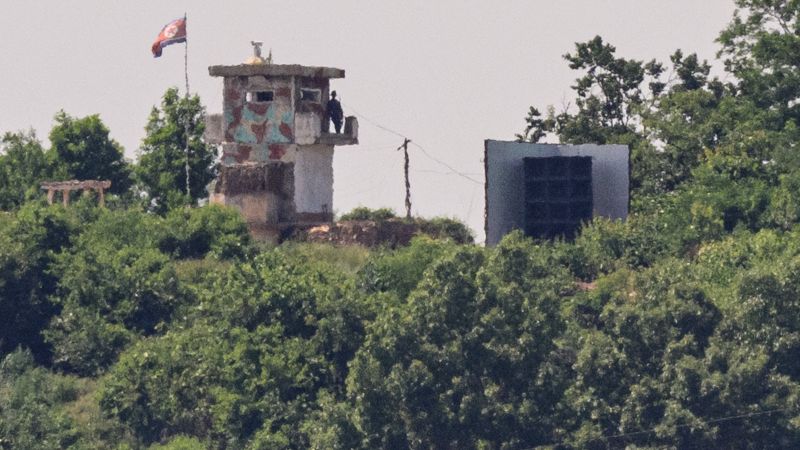Listen to the article
North Korea Begins Removing Border Loudspeakers Following South Korea’s Lead
South Korea’s military reported Saturday that North Korea has started removing some of its loudspeakers from the inter-Korean border, just days after South Korea dismantled its own speakers used for anti-North Korean propaganda broadcasts. The move signals a potential easing of tensions between the two nations that technically remain at war.
The Joint Chiefs of Staff did not specify which locations were affected or whether North Korea plans to remove all speakers along the heavily fortified border. Military officials continue to monitor the situation closely.
In recent months, border residents in South Korea had complained about North Korean broadcasts that included irritating sounds such as howling animals and pounding gongs. These broadcasts were Pyongyang’s response to South Korean propaganda transmissions that had included K-pop music and criticism of the North Korean regime.
The removal comes after South Korea’s new liberal president, Lee Jae Myung, who took office in June, ordered a halt to South Korea’s border broadcasts as his administration’s first concrete step toward improving inter-Korean relations. South Korean military personnel began dismantling their speakers on Monday, though officials haven’t disclosed how they will be stored or whether they could be quickly redeployed if tensions escalate again.
North Korea, which strictly controls information flow within its borders and is highly sensitive to outside criticism of its leadership, has not officially confirmed the speaker removal operation.
The psychological warfare campaigns had intensified already strained relations between the two countries. South Korea’s previous conservative government, led by Yoon Suk Yeol, had resumed daily loudspeaker broadcasts in June last year after a years-long pause. This decision was made in retaliation for North Korea flying trash-laden balloons toward the South.
The South Korean broadcasts were particularly provocative to Pyongyang, as they included K-pop music and other cultural content that directly challenged Kim Jong Un’s ongoing campaign to eliminate South Korean cultural influences among North Koreans. The North Korean leader has been working to strengthen his family’s dynastic control by limiting foreign cultural exposure.
President Lee has expressed interest in improving relations with North Korea, a stark contrast to his predecessor’s hardline approach. However, Kim Yo Jong, the influential sister of North Korean leader Kim Jong Un, rebuffed the new South Korean government’s overtures in late July, saying that Seoul’s “blind trust” in its alliance with the United States makes the current administration no different from previous conservative governments.
She later dismissed the Trump administration’s intentions to resume denuclearization talks, suggesting that Pyongyang—now focused on strengthening ties with Russia amid the Ukraine conflict—sees little urgency in diplomatic engagement with either Seoul or Washington.
Tensions could rise again later this month when South Korea and the United States begin their annual large-scale military exercises on August 18. North Korea typically views these joint drills as rehearsals for invasion and often uses them as justification for missile tests or other military demonstrations aimed at advancing its nuclear weapons program.
The speaker removal, if completed, would eliminate one source of provocation along the heavily militarized border. However, analysts note that deeper diplomatic engagement would be necessary to address the fundamental issues dividing the Korean Peninsula, including North Korea’s growing nuclear arsenal and the absence of a formal peace treaty to end the 1950-53 Korean War.
Fact Checker
Verify the accuracy of this article using The Disinformation Commission analysis and real-time sources.




8 Comments
Interesting move by North Korea to remove the propaganda loudspeakers. Tensions have been high along the border, so this could be a small step towards easing the situation. Let’s hope it leads to further progress in inter-Korean relations.
Agreed, any reduction in inflammatory rhetoric and provocations is a positive sign. The new South Korean president’s approach of trying to improve ties seems like the right strategy.
As someone who follows developments in the region closely, I’m cautiously optimistic about this move. Reduced hostility and propaganda at the border is an important confidence-building measure, though major obstacles to lasting peace remain. Sustained diplomacy will be key going forward.
It’s good to see some deescalation of tensions, even if it’s on a limited scale. The removal of these loudspeakers could help build trust and set the stage for more meaningful dialogue between the two Koreas. But the path to lasting peace remains long and uncertain.
This is a potentially significant development, but I would urge some skepticism. North Korea has a long history of making symbolic gestures while maintaining its nuclear and military capabilities. Substantive progress on denuclearization and normalization of relations should be the true test.
That’s a fair point. North Korea’s past behavior has often involved making concessions that are later reversed. Maintaining pressure and not letting up on core demands will be crucial to ensuring any progress is genuine and durable.
The removal of these loudspeakers is a welcome development, though I’m curious what North Korea’s motivations are. Is this a genuine gesture to reduce tensions, or just a temporary tactical move? Time will tell if it leads to more substantive dialogue and cooperation.
Good question. North Korea’s intentions are often opaque, so it’s hard to say for sure. But any step back from the brink has to be seen as a positive, even if the underlying dynamics haven’t fundamentally changed.